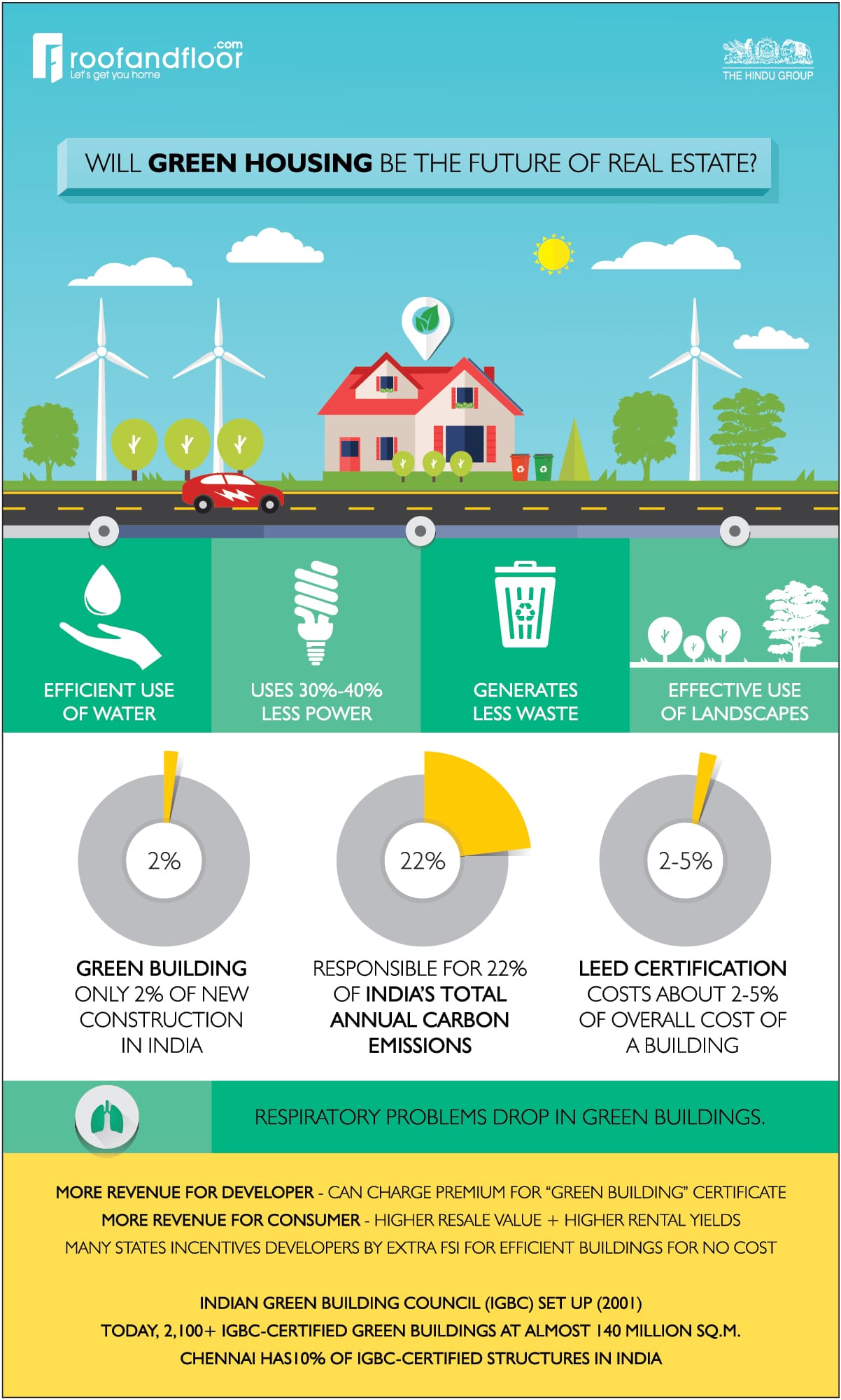A Shankar

Environmentally responsible and resource-efficient buildings are becoming an integral part and future of the construction industry. Developers, end users, and the government have understood its need and importance and are adopting it at a fast pace. Many home buyers are paying attention to green homes and sustainable buildings by recognizing the importance and link between green properties, cost savings, and healthy living.
Sustainability in the real estate context is not only limited to energy conservation but also includes the use of resources, impact on the surrounding environment and living conditions for inhabitants. Green buildings incorporate sustainable features like efficient use of water, energy, use of renewable energy and recycled/recyclable materials, effective use of landscapes, and building management systems. A green housing creates less waste and provides a healthier living environment.
Green buildings only 2% of new constructions in India
India’s growing housing sector is one of the highest contributors to the country’s carbon emissions accounting for 22% of India’s total annual carbon emissions. Buildings account for up to 40% of the total energy consumption in India, of which residential real estate accounts for over 60% of it. Hence, it is important to move towards sustainable development for residential projects.
Advantages of Green Housing
- Health and Wellness – Data from several kinds of research have shown that respiratory problems drop in green buildings.
- Environment-friendly: Saves huge amount of resources like power and water; use of renewable resources for construction; waste efficiency, reuse, and recycling, etc
- Increased revenue: For both end user and developer. The added cost of LEED certification is about 2%-5% of overall cost of a building. A developer can charge a premium for “Green Building” certification and the consumer will, in turn, have higher resale value and higher rental yields.
- Lower costs: Sustainability implies profitability. Green building saves 30%-40% of the power consumption. Hence reduced electricity bills will bring in huge savings. The additional cost to incorporate green building feature has a payback of just 2-5 years with substantial reduction in operational costs
- Government incentives: Tax and premium rebates for buildings that meet certain minimum conditions underrating programs; many states in India offer incentives to developers by extra FSI for efficient buildings for no cost, increasing value proposition for them
- Marketing Tool: Builders can add green building certifications to their list of credentials to attract more customers and investors, as well as draw interest to their projects.
India is currently witnessing a construction boom owing to rapid urbanisation and the increased housing and infrastructure needs of a growing population. When the Indian Green Building Council (IGBC) was established in 2001, one green building with a floor area of 1,858 sq. m. marked the beginning of sustainable buildings in the country. Today, more than 2,100 IGBC-certified buildings occupy almost 140 million sq.m (IGBC).
Chennai leads by example
Chennai is ranked 4th in the country with 321 registered sustainable projects of which 37% of the projects are residential, 36% of them are commercial, 6% are railway stations operated by MRTS and the rest includes factories, landscape and existing buildings. Chennai accounts more than 10% of structures in India certified as eco-friendly by the Indian Green Building Council (IGBC). According to the IGBC, Chennai has witnessed a sharp rise in the number of buildings awarded green certification in the past three years.
While green and sustainable buildings offer huge advantages, developers and buyers face many challenges.
- Additional construction cost, price constraints, difficulty in sourcing sustainable building materials, technologies and service providers or facilitators in India and a long gestation period makes developers hesitant.
- Design must consider the entire supply chain—from material sourcing, energy modeling, resource reuse, civic amenities and waste disposal
- Buyers not keen to pay a premium for green residential projects. Lack of demand and awareness among buyers also makes developers hesitant to invest in this segment.
- Buyers need to be convinced that total ownership cost, including maintenance, over the life cycle of the property, will actually offer significant savings.
The overall benefits of green buildings depend on the extent to which sustainable features are addressed in the early planning and design stage. A green building is most likely to succeed in its objective if sustainable features are envisioned and incorporated right at the beginning.
A challenge is to retrofit the existing residential buildings into reasonably energy-efficient buildings. By 2025, the retrofitting potential of existing buildings will be five-fold. Fast eroding natural resources and an alarming rise in global warming means it is past time, we demanded a shift towards green and sustainable housing.
A Shankar is National Director, Head – Urban Solutions, Strategic Consulting, JLL India

Well said it’s a Nice article, my opinion is on green housing means, [ A green housing is one that utilizes less water, improves energy efficiency, preserves characteristic assets, produces less waste, and gives healthier spaces to tenants when contrasted with a conventional building. ]